How many shafts would you need to weave that pick up pattern?
draftspick-up
Pick up sticks are a great way to go beyond plain weave on a rigid heddle loom. But how do they relate to shafts on a floor or table loom? It turns out it’s not so simple as saying that a number of pattern sticks equals a number of shafts, as the interactions between sticks are different than the interactions between shafts.
Weaving drafts consist of a threading (which yarns go through which shaft), the tie-up or lift plan (which combinations of shafts are used), and the treadling (the order the combinations of shafts are used). As we'll see, in some cases, pick up sticks can give you patterns that would require many more shafts than different pick up patterns, but only a subset of the possible shaft combinations from the tie up or lift plan. In other cases, we can set up a rigid heddle loom so that sticks map to different shafts.
Most kinds of pick up work with multiple sticks are done with one stick that is left in place, and either a second stick that is moved as required, or, one or more heddle rods. For simplicity I’ll mostly just talk about sticks except for a few cases where a heddle rod can be particularly useful; in general, a heddle rod is useful when doing large segments of the same multi-stick pattern, while it's easier to reposition a stick for smaller areas.
For consistency, in this post, stick A is in the back and stick B is in the front, and I've numbered shafts so that 1 is the holes, then middle numbers are picked up on different sticks from back to front, then any combinations of sticks, and finally any yarns that are not picked up on any stick. Keep in mind that this mapping is arbitrary and can be changed as is convenient for a particular draft. In the photos, you'll see a piece of cardboard in addition to the stick(s) - the slot yarns go over the cardboard while the holes are underneath; this can help separate the layers for easier pick up.
One Stick #
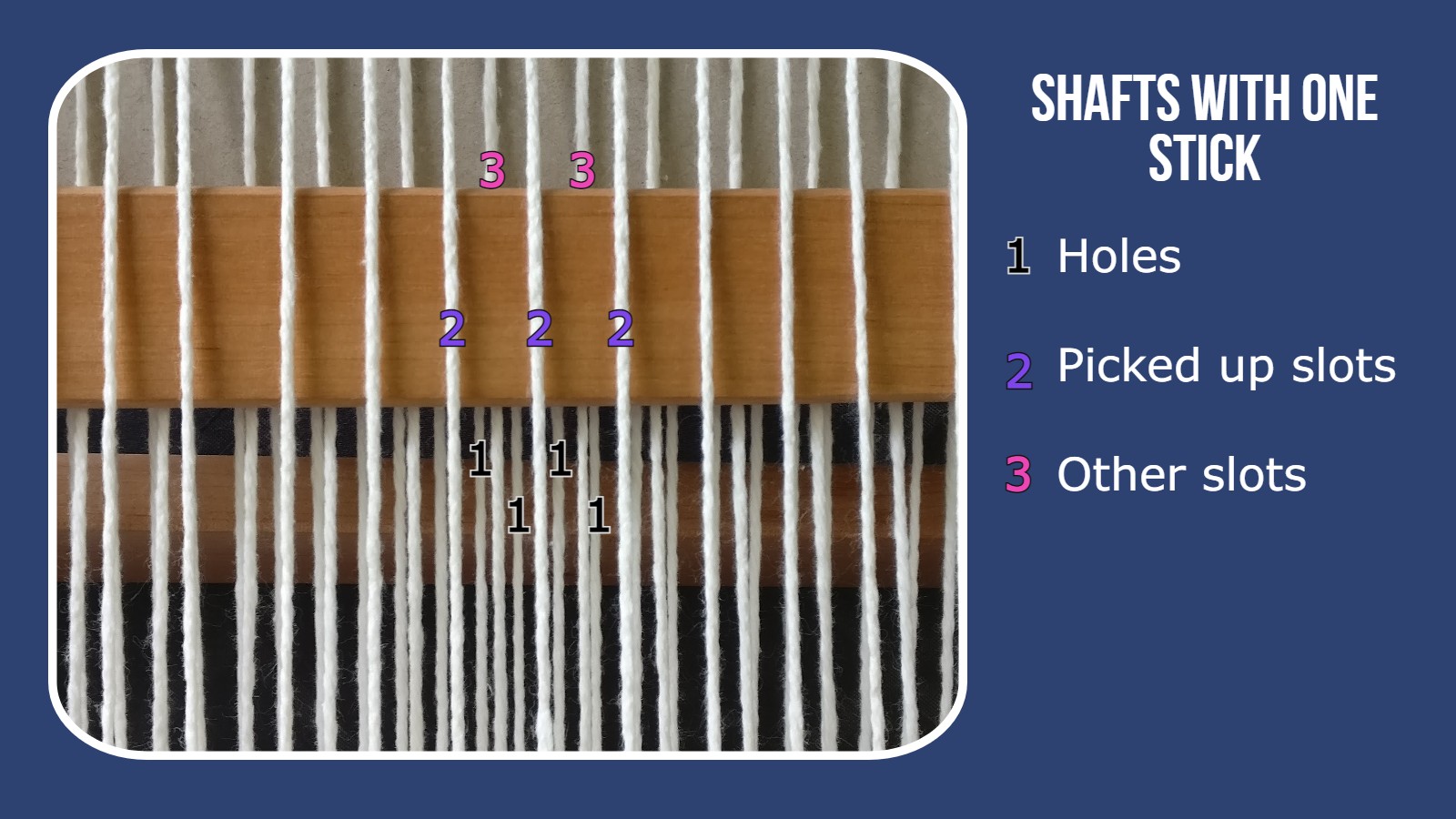
To start with, let's think about how a pattern with one stick relates to shafts. With one pick up stick in one position, such as 1 up, 1 down as in the picture, you can think of your shafts as follows:
- Holes
- Picked up slot yarns
- Other slot yarns (the ones that aren't picked up)
This gives you the following possible heddle and stick positions:
- Up: Shaft 1
- Down: Shaft 2 + 3
- Neutral + Stick: Shaft 2 (Weft Floats in gaps)
- Up and Stick: Shaft 1 + 2 (Warp floats in the picked up warps)
However, the following shaft combinations are not possible with one stick.
- Shaft 3
- Shaft 1 + 3
That is to say, we need 3 shafts to weave a pick up pattern on a floor loom, but not all (or even most!) 3 shaft patterns can be woven using one pick up stick, due to not being able to get the Shaft 3 sheds except in combination with Shaft 2.
Two Sticks #
The first pick up stick gives us a 3rd, limited shaft, but with two sticks, there are 5 different scenarios for how 2 different pick up patterns can interact, requiring anywhere from 3 to 5 shafts! The key difference between a stick and a shaft is that a yarn can go through only one shaft but it can be picked up by more than one stick, or none, and it's in those interactions that things can get complicated!
Scenario 1: Picking up opposite yarns #
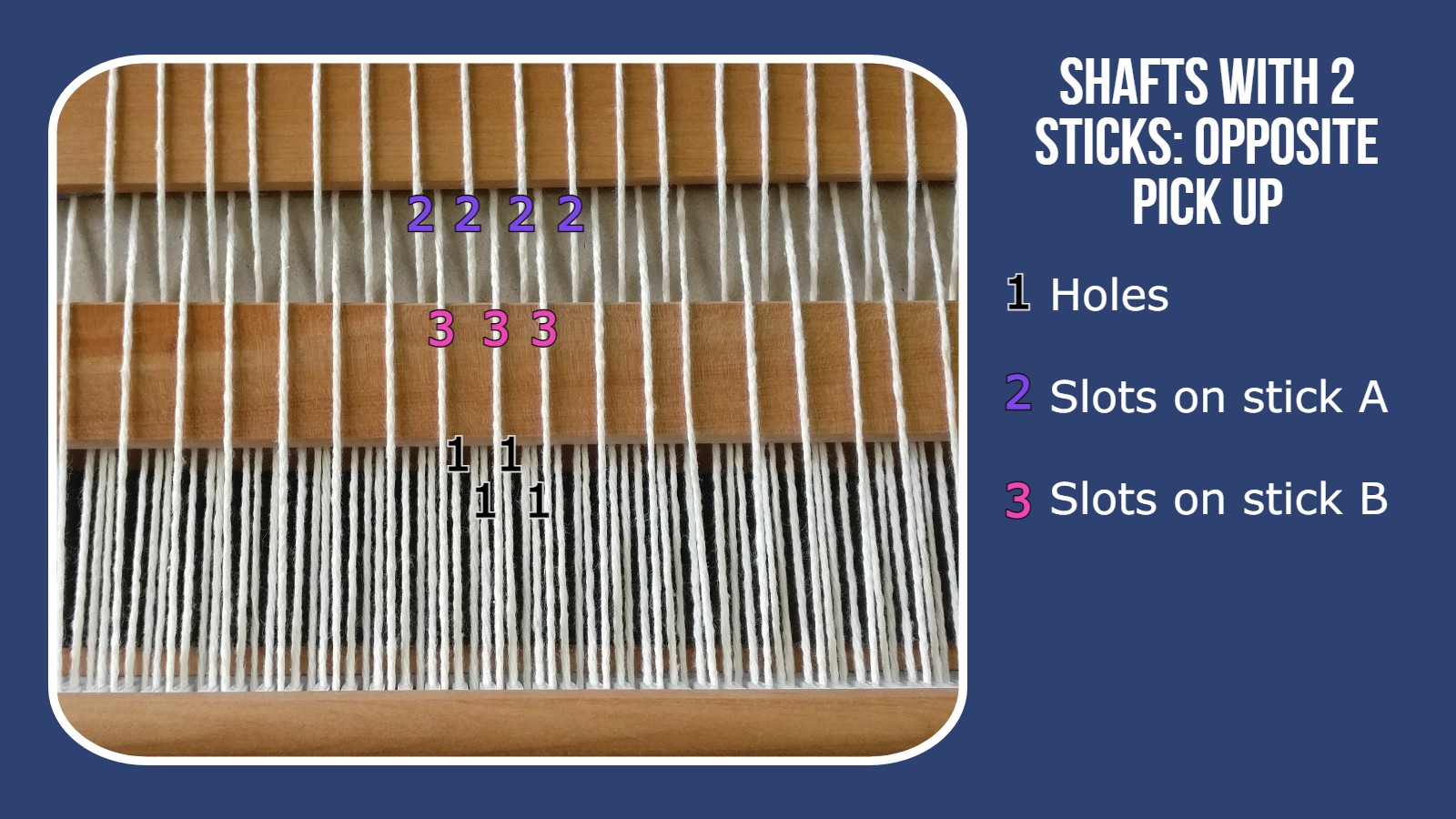
A very common use of a second pick up stick is to pick up all of the opposite yarns. This gives us access to all 3 shaft tie up combinations. Pictured is 1 up, 1 down on one stick and 1 down, 1 up on the other.
Example Pick Up Patterns:
- A: 1 up, 1 down
- B: 1 down, 1 up
- Holes
- Slots on Pick Up A
- Slots on Pick Up B
The possible combinations are:
- Up: 1
- Down: 2, 3
- Up and stick A: 1, 2
- Up and Stick B: 1, 3
- Neutral + Stick A: 2
- Neutral + Stick B: 3
This kind of setup where every yarn is either in a hole or picked up by exactly one stick or heddle rod works is the most natural for converting from a multi-shaft draft to a rigid heddle loom, and gives you access to all shaft combinations. If you're doing a 3-shaft pattern this way for more than a short section, you probably want to use a heddle rod for one shaft.
Examples: Many 2 stick patterns fall into this category, e.g. Honeycomb (Weaver's Idea Book, pg 113), Paired Warp Floats in Alternating Blocks (Weavers' Idea Book pg 97). This scenario also covers any arbitrary 3 shaft pattern, when combined with a suitable threading, like a 3 shaft twill or Krokbragd.
Scenario 2: Picking up different patterns where all yarns are picked up #
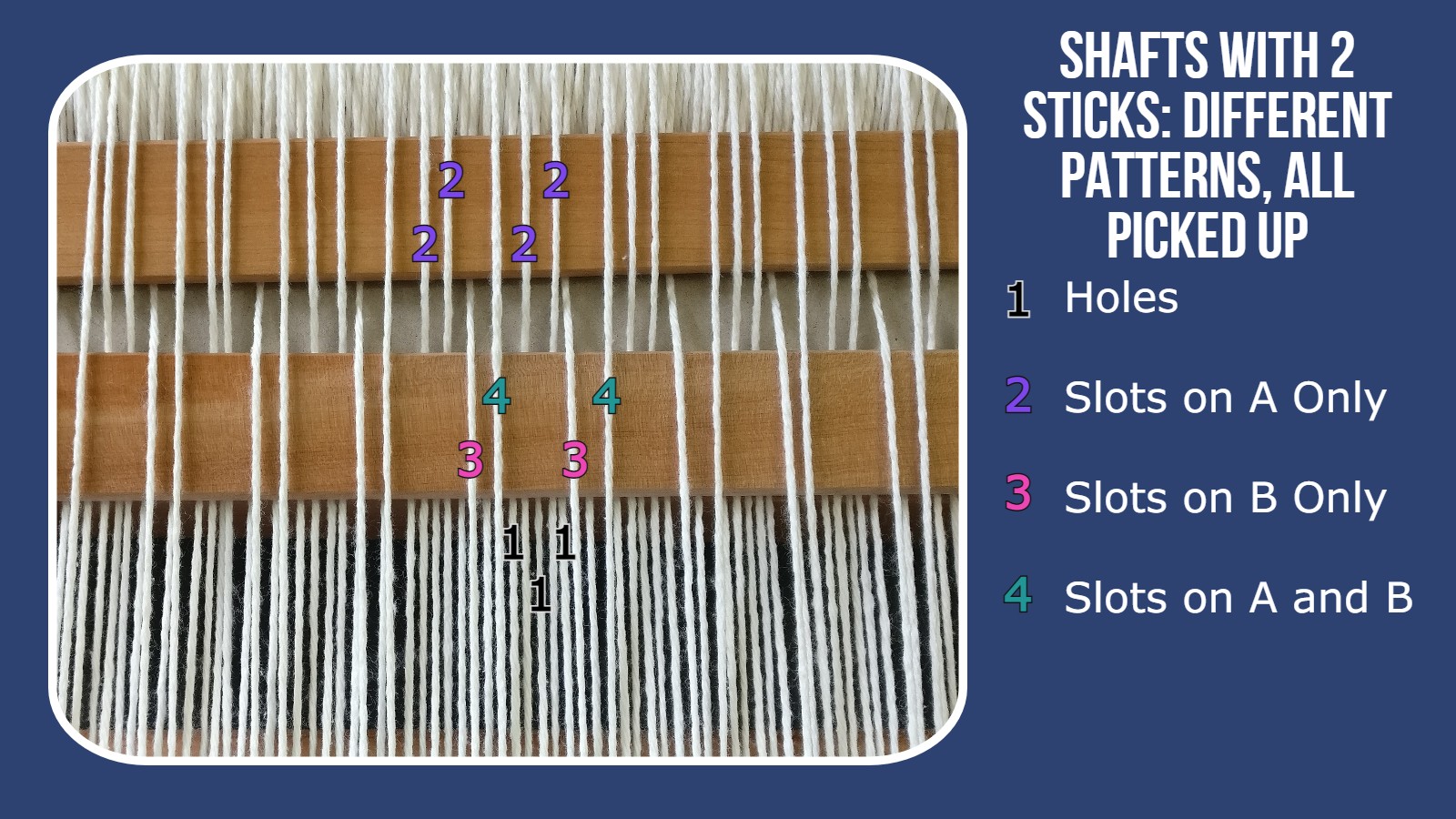
In this scenario, each stick picks up a different pattern but the total number of yarns in the pattern repeat is the same so all yarns are picked up by at least one stick, and some are picked up by both. Pictured, I have 3 up, 1 down and 2 up, 2 down - both patterns work with 4 slot yarns. This needs 4 shafts, since while a yarn can easily be picked up by multiple sticks, it can't go through more than one shaft, and if converting to shafts we need a shaft for the intersection of A and B.
Example Pick Up Patterns:
- A: 3 up, 1 down
- B: 2 up, 2 down
Shafts:
- Holes
- Slot yarns that are picked up by Stick A only
- Slot yarns that are picked up by Stick B only
- Slot yarns that are picked up by both A and B.
The possible combinations are:
- Up: 1
- Down: 2, 3, 4
- Up and stick A: 1, 2, 4
- Up and Stick B: 1, 3, 4
- Neutral + Stick A: 2, 4
- Neutral + Stick B: 3, 4
Example: Texture with Warp and Weft Floats (Weaver's Idea Book, pg 102)
Scenario 3: Picking up different patterns where not all yarns are picked up, no overlap. #
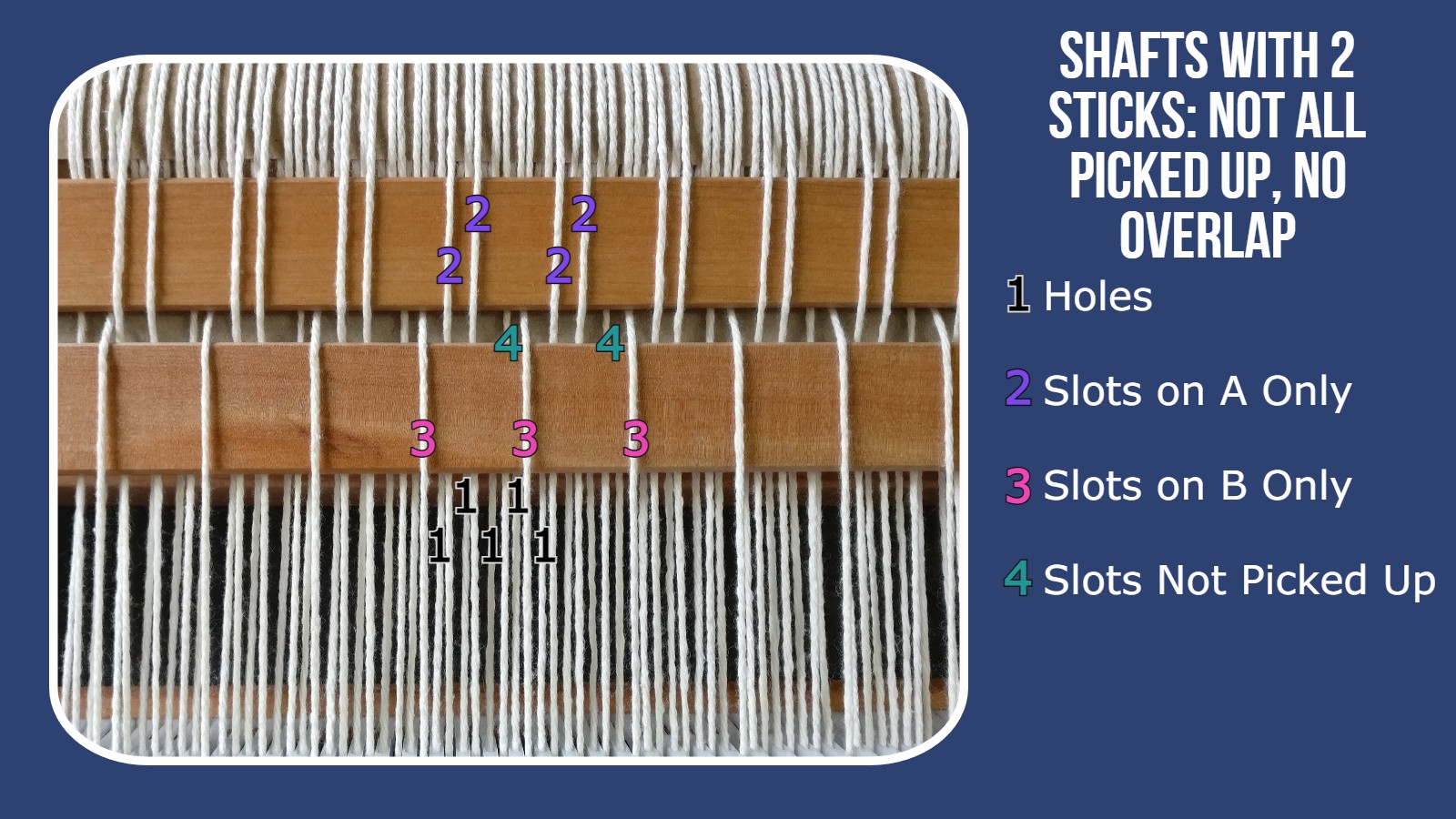
This scenario gives us a different set of 4 shaft possibilities than scenario 2. We have 3 shafts which can be used on their own and in some combinations and a limited 4th shaft that's only usable in one combination.
Example Pick Up Patterns:
- A: 2 up, 2 down,
- B: 3 down, 1 up
Shafts:
- Holes
- Slot yarns that are picked up by Stick A
- Slot yarns that are picked up by Stick B
- Slot yarns that aren't picked up by either stick
The possible combinations are:
- Up: 1
- Down: 2, 3, 4
- Up and stick A: 1, 2
- Up and Stick B: 1, 3
- Neutral + Stick A: 2
- Neutral + Stick B: 3
- Up and stick A and B: 1, 2, 3 (Only possible if at least one is a heddle rod)
- Neutral and stick A and B: 2, 3 (Only possible if at least one is a heddle rod)
Examples: Spot Lace, (Weaver's Idea Book, pg 86), Deflected Warps, (Weaver's Idea Book, pg 129).
Scenario 4: Picking up different patterns where not all yarns are picked up #
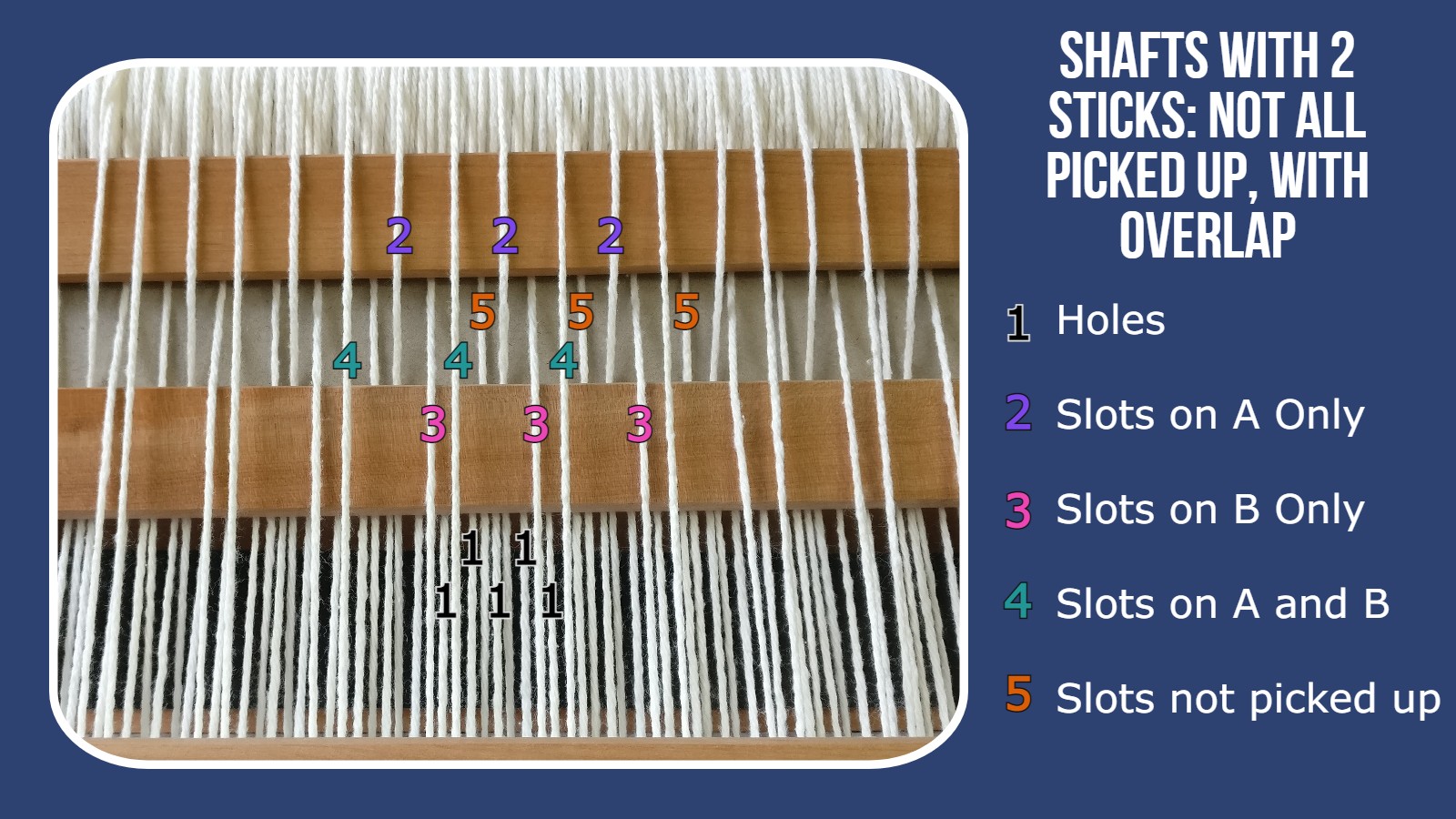
In this scenario, each stick is picking up a different pattern and some yarns are not picked up. Pictured, I have 1 up, 1 down and 2 up, 2 down. This actually needs 5 shafts, because we have both interactions of picked up yarns and yarns that aren't picked up.
Example Pick Up Patterns:
- A: 1 up, 1 down
- B: 2 up, 2 down
Shafts:
- Holes
- Slot yarns that are picked up by Stick A only
- Slot yarns that are picked up by Stick B only
- Slot yarns that are picked up by both A and B.
- Slot yarns that aren't picked up by either stick
In this case, if one of the patterns is set up on a heddle rod it's possible to get 8 different tie ups (out of the 30 possible with 5 shafts) instead of 6 by using stick and heddle rod together.
The possible combinations are:
- Up: 1
- Down: 2, 3, 4, 5
- Up and stick A: 1, 2, 4
- Up and Stick B: 1, 3, 4
- Neutral + Stick A: 2, 4
- Neutral + Stick B: 3, 4
- Up and stick A and B: 1, 2, 3, 4 (Only possible if at least one is a heddle rod)
- Neutral and stick A and B: 2, 3, 4 (Only possible if at least one is a heddle rod)
Example: 3x3x2x2 Squares (Weaver's Idea Book, pg 101)
In this case, we have access to many 4 shaft combinations, but only one combination involving the 5th shaft.
Scenario 5: Picking up a subset of yarns #
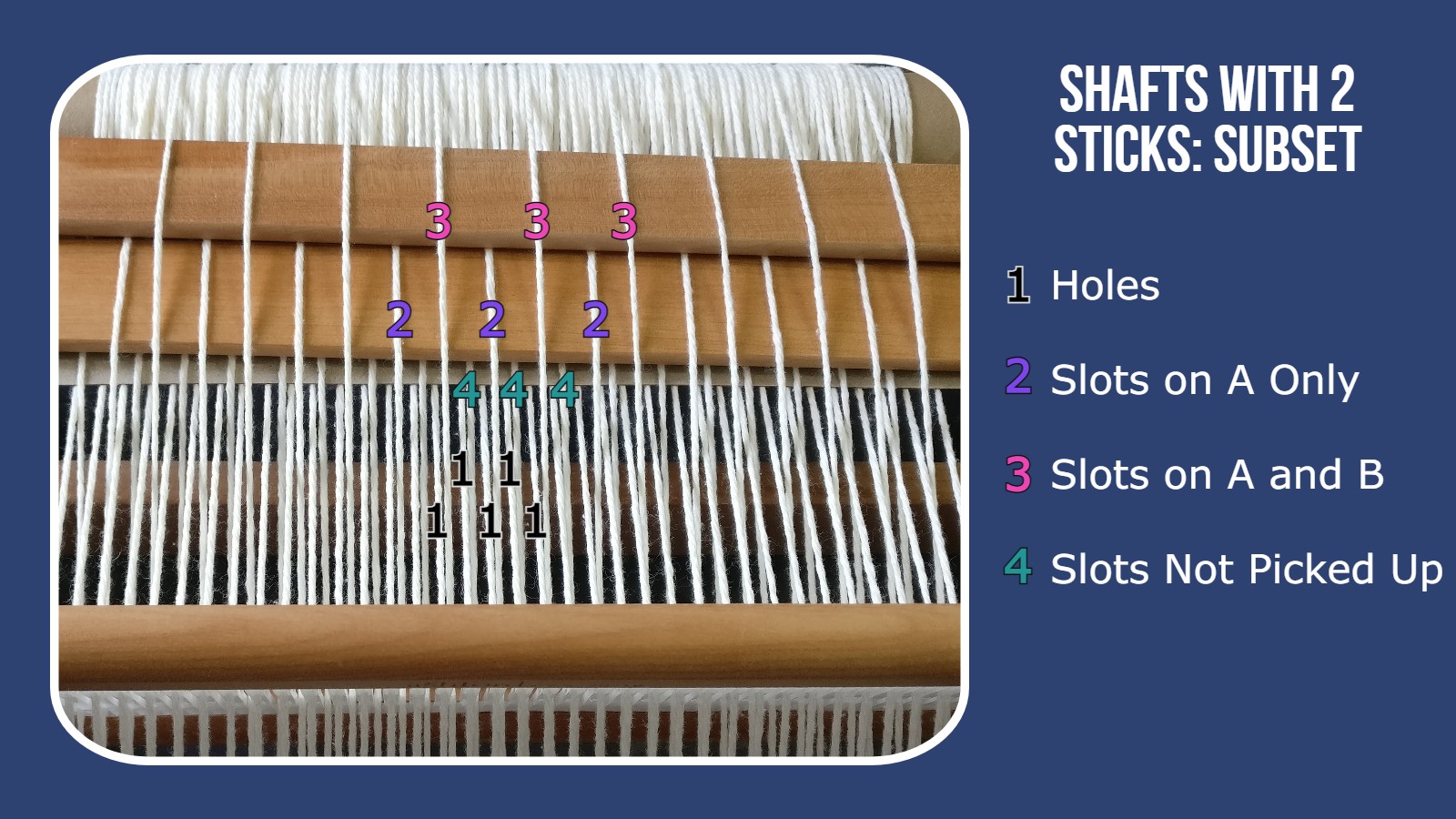
This scenario has 2 use cases: patterns where you are making filled in shapes out of texture with different rows, or where you want both warp and weft floats that don't go across the whole piece. In this case, the sticks CAN slide past each other if the stick picking up fewer yarns is on top. Usually the top stick would be used for warp floats and the bottom for weft floats as the opposite may produce very large weft floats on one side of the fabric.
Example Pick Up Patterns:
- A: 1 up, 1 down (Bottom stick)
- B: 1 up, 3 down (Top stick)
Shafts:
- Holes
- Slot yarns that are picked up by Stick A only
- Slot yarns that are picked up by both A and B.
- Slot yarns that aren't picked up by either stick
The possible combinations are:
- Up: 1
- Down: 2, 3, 4
- Up and stick A: 1, 2, 3 (Large weft floats on back)
- Up and Stick B: 1, 3 (Typical warp floats)
- Neutral + Stick A: 2, 3 (Typical weft floats)
- Neutral + Stick B: 3 (Large weft floats on front)
Example: Bronson Check on a Rigid Heddle Loom
Beyond 2 sticks #
We've worked through all the possible combinations with 2 shafts, and as we see there's a lot of different ways even 2 sticks can interact. How does that generalize?
The shaft requirements for n different pick up patterns can be up to:
1 shaft for the hole yarns + 2^n possible combinations of yarns on pick up sticks. With 2 this is 5, with 3 this is 9, with 4 this is 17, and with 5, 33. If you'd like more info on the math behind that, it's the number of k-combinations for all k (Wikipedia).
For example, with 3 different patterns, we could have in the extreme case:
- Holes
- Slot yarns that are picked up by Stick A only
- Slot yarns that are picked up by Stick B only
- Slot yarns that are picked up by Stick C only
- Slot yarns that are picked up by Stick A and B
- Slot yarns that are picked up by Stick A and C
- Slot yarns that are picked up by Stick B and C
- Slot yarns that are picked up by Stick A, B, and C
- Slot yarns that aren't picked up
To be clear, this is an upper limit, not a typical value! For an actual example, one of the the more complicated drafts in the Weaver's Idea Book is the weft float sampler on pg. 103 which uses 5 different pick up patterns, and the provided draft uses 10 shafts, well short of the possible 33.
The easiest translation of a floor loom draft to pick up on a rigid heddle loom would be to put each shaft on a heddle rod (perhaps one on a stick) with one shaft (ideally the most common) through the holes, requiring n - 1 sticks or heddle rods to make n shafts. It may be possible to reduce that in some cases, though I'll leave that as a topic to explore in the future!
Conclusion #
Floor looms are wonderful machines and are efficient at weaving patterns that work within the number of shafts, but the beauty of pick up sticks on a rigid heddle is that you can move them around, introducing as much or as little complexity as you'd like. A 4 shaft loom can more easily weave a 4 shaft pattern than a rigid heddle loom can, but a rigid heddle loom can more easily weave an 8 shaft pattern than the 4 shaft loom can.
It would be fairly laborious to weave a section with a complex treadling through various changing pick up patterns, as would often be the case if starting from a floor loom draft and converting to rigid heddle, but, there are kinds of patterns that lend themselves well to this kind of technique, allowing weaving complex patterns on a simple loom. One is simply the idea of having different kinds of detail in different sections of a piece - any given section can be a simple pick up pattern but the combination could easily get beyond the capability of a typical floor loom on a single warp. Another is the idea of making large designs of textured areas where a stick is moved around every few pattern repeats; this can be fairly simple to pick up when the pattern simply adds or drops a few yarns each change. A third category is structures that involve a mix of plain weave (also known as tabby) rows mixed with pattern rows, like overshot, summer and winter, etc., where you can explore variations that would take a lot of shafts by using pick up techniques. Finally, this can be used for small sections of detail - for example, a row or two of pinwheels (an 8 shaft pattern) can be quite lovely, though an entire towel of pinwheels is quite time consuming.
I hope you enjoy exploring complex patterns with pick up sticks!
Check out Not So Rigid Designer, the online weaving software for rigid heddle loom weavers!
